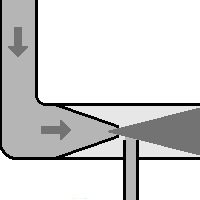|
|
Fuel Tank 1
Function
Fuel for internal combustion engines has an especially high energy density. Therefore, the most important task for the fuel tank is protection against leaking fuel, also during light and perhaps moderately severe
accidents. Because modern vehicles may also not emit any fuel gases, these must be temporarily stored and later on supplied to the engine. Drivers expect trouble-free refuelling and the designer wants to fill with the
tank volume not otherwise usable hollow cavities.
How it works
The classical fuel tank manufactured from two sheet metal parts which are connected to each other by unwinding weld clamps and which are covered with a corrosion prevention layer seems more and more seldom
in passenger cars. The plastic tank allows a substantially better exploitation of the available hollow cavities and is lighter. Because also with rear-driven vehicles the fuel tank is often mounted under the rear bench, it
receives because of the cardan shaft a clear cavity in the shape. Due to these cavities two fuel pumps or at least one electric pump and an ejector pump have to be used. The picture displays the fuel coming from the
top left flowing to the right towards the engine. A depression develops if the fuel is pressed through a nozzle. The fuel from below is carried along by the fuel current in the tank. During an accident the filler neck can easily break or become leaky, therefore a plastic tank is advantageous.
Metal sheet tanks still feature baffle plates for stiffening the container and against extreme fuel shifts, e.g., with cornering; this can be taken into account with plastic tanks during designing or be poured in with.
However, lately, the sealing required particularly by American legislation is so strong that again the metal sheet tank is preferred. In an accident the plastic tank has no disadvantages. Also after its introduction in the
year 1973 no expert for vehicle fires has experienced an explosion of the tank.The plastic-tank is manufactured from PE which behaves in case of a fire more
favourably than sheet steel. It does not glow and therefore passes on the heat, but still covers fuel leftovers. During an accident the filler neck can easily break or become leaky, therefore a plastic tank is advantageous.
Metal sheet tanks still feature baffle plates for stiffening the container and against extreme fuel shifts, e.g., with cornering; this can be taken into account with plastic tanks during designing or be poured in with.
However, lately, the sealing required particularly by American legislation is so strong that again the metal sheet tank is preferred. In an accident the plastic tank has no disadvantages. Also after its introduction in the
year 1973 no expert for vehicle fires has experienced an explosion of the tank.The plastic-tank is manufactured from PE which behaves in case of a fire more
favourably than sheet steel. It does not glow and therefore passes on the heat, but still covers fuel leftovers.
On top in the figure a fuel tank with inside tank pump is visible. It is mounted together with the advance, runback, swirl pot and level transducer under the big screw able lid. Besides, the swirl pot is always filled with
fuel and prevents with old-timers in long pulled bends dreaded declining supply of fuel.Several pipes are connected with the actual fuel tank:
- advance to the fuel injection system (small cross section),
-
runback from the fuel injection system (small cross section),
- ventilation as pressure equalisation during the suction process
(small cross section),
- vent pipe while refuelling (big cross section).
None of these pipes may lead with modern vehicles into the open air. While the tank vent pipe ends on top in the filler neck and is sucked off by the nozzle, the ventilation pipe flows into the carbon canister. Here
the petrol portions are detained so long, until they are supplied at a certain time, determined by the engine control unit, via a stroke valve to the engine and are burnt there.
Shut-down
Whether a vehicle should be shut-down with full or empty tank depends on the tank material. Plastic tanks must not be filled, while metal sheet tanks should be full if they do not have any protection layer inside. This is
valid, e.g., for motorcycles for which the investigation of the tank is an important measure for the determination of its value.
|
|